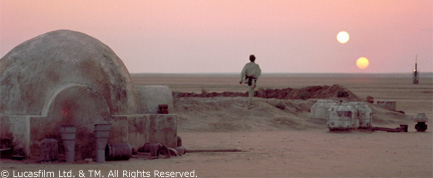'Star Wars' Planet with 2 Suns Challenges Theories

A huge alien planet discovered in a system with two suns akin to the fictional "Star Wars" world of Tatooine is forcing astronomers to rethink their theories about how gas giant planets form.
The two stars are close enough together that the leading theory for planet formation — that dust and gas circling the stars slowly accrete into such planets' rocky cores — isn't likely, researchers said. The stars' gravity would disrupt this process long before it could get very far, they added. [Gallery: The Strangest Alien Planets.]
Instead, the new findings support an alternative theory, called gravitational collapse, which holds that super-dense regions of the dust cloud form planets much more rapidly, pulling together via the force of their own gravity.
The new planet is about the size of Jupiter. It orbits the star HR 7162, which is part of a binary star system 49 light-years away, in the constellation Lyra.
The researchers found the planet using a method called astrometry, which precisely tracks the position of stars over time. The discovery marks the first time astronomers have used astrometry to find a previously unknown planet, researchers said.
"The techniques we're developing could help us better locate Earth-like planets in our local neighborhood in the galaxy," said study leader Matthew Muterspaugh of Tennessee State University in a statement.
A double sunset world
Get the world’s most fascinating discoveries delivered straight to your inbox.
The new gas giant isn't the only known planet with more than one sun.
Researchers have discovered dozens of them, meaning double sunsets like those seen on Luke Skywalker's home planet of Tatooine in the "Star Wars" films may not be so rare.
To find the planet using astrometry, Muterspaugh and his team studied the periodic variations in the star HR 7162's location, which indicated something big was tugging on it with its gravity, betraying the presence of the new extrasolar planet.
In principle, the astrometry method is similar to the radial velocity technique, which has been extremely successful at detecting planets' gravitational pull by analyzing the speed at which stars are moving toward or away from Earth.
The researcher is detailed in a series of five papers in The Astronomical Journal.
Second star too close
The companion star near HR 7162 is close enough to its stellar partner and the new planet that its gravitational pull could have affected planet formation, researchers found. This finding challenges the leading model of giant planet formation, called core accretion, they added.
In core accretion, dust and gas particles circling a young star cling together and gradually become larger, forming rocks, boulders and eventually the stony cores of planets. The process of creating rocks from scattered dust requires millions of years to form Jupiter-like planets, researchers said.
According to models of the HR 7162 system's evolution, the second star's gravity should have disrupted the planet-forming gas and dust in just thousands of years, ejecting this raw material from the system.
That a planet exists in spite of these predictions challenges core accretion as the singular model for gas giant planet formation, researchers said.
Gravitational collapse offers an alternative method of forming giant planets, according to the team. In this theory, dense parts of the gas and dust cloud develop enough gravitational attraction within themselves to rapidly pull together into giant planets.
Simulations show these regions can collapse fast, well within a few thousand years — meaning that the planet-forming materials could have survived in HR 7162 before the second star booted them out.
Some studies suggest that binary star systems produce more super-dense regions in their gas and dust clouds, because of the turbulent gravitational environment the two stars create. This would enhance the odds of giant planet formation by gravitational collapse, researchers said.



